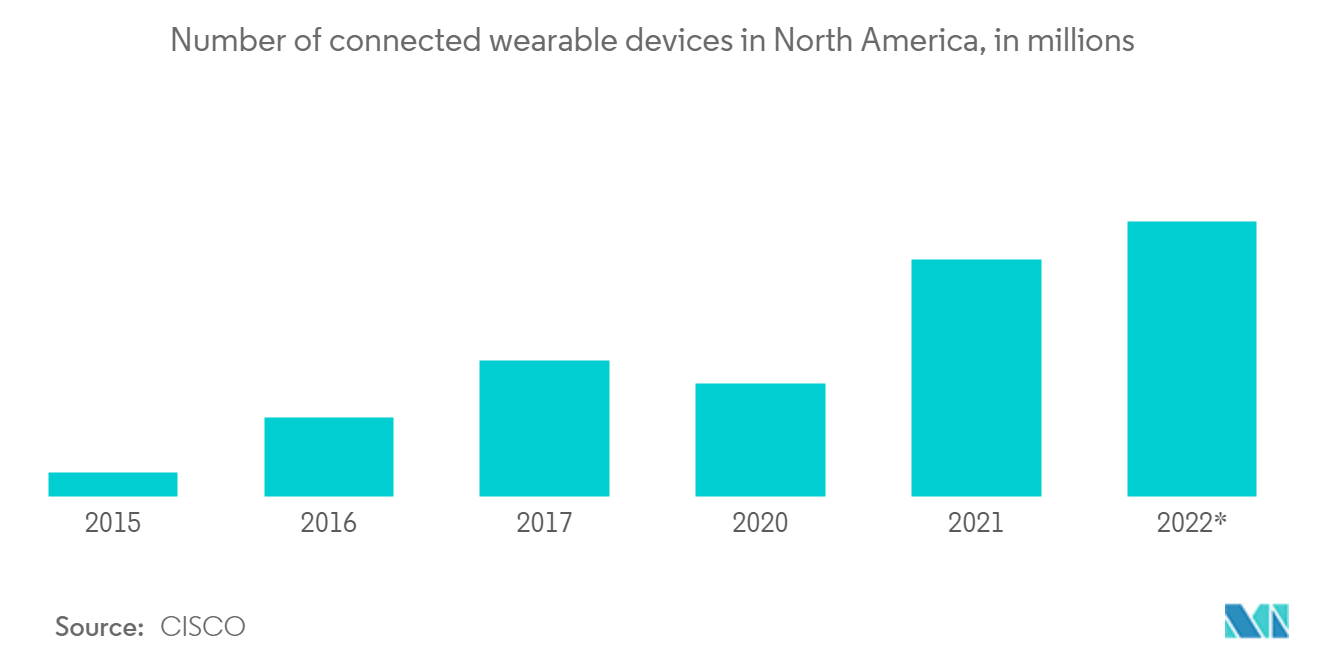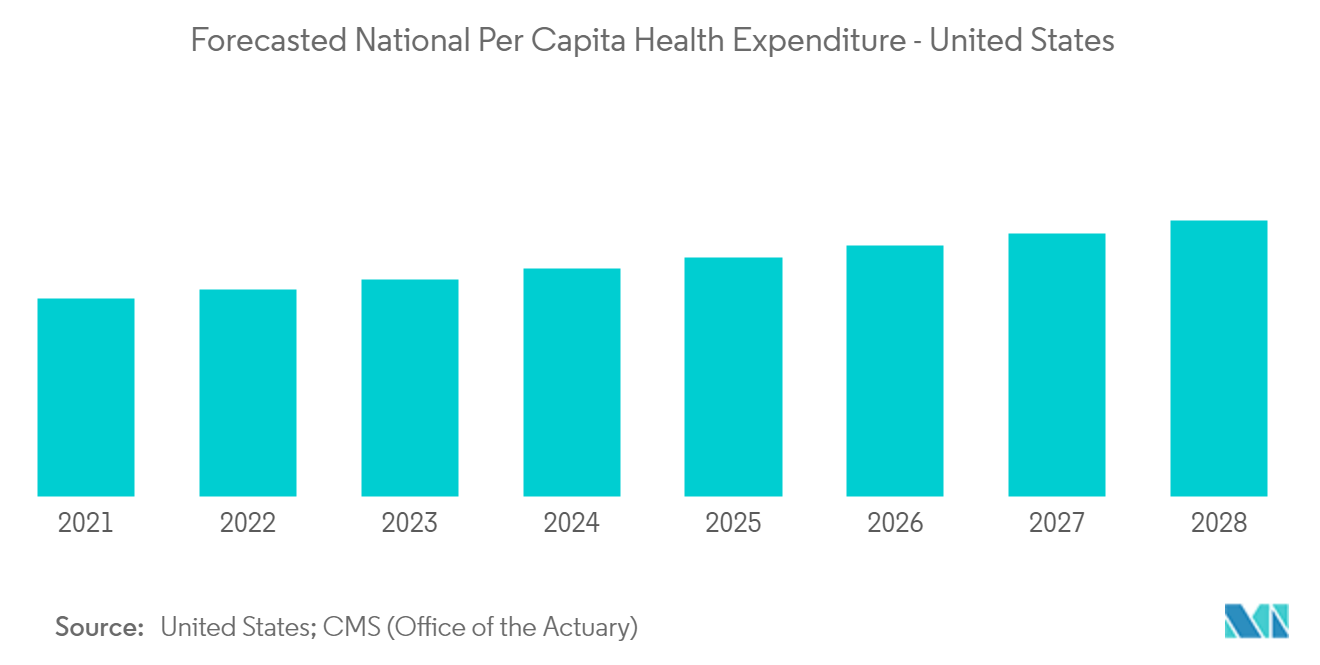Market Trends of US Biomedical Sensors Industry
This section covers the major market trends shaping the US Biomedical Sensors Market according to our research experts:
Growing Demand for fitness devices to Drive the Market Growth
- The incidence and prevalence of lifestyle-related illnesses such as diabetes and hypertension are expected to rise over the projection period as a result of the sedentary lifestyle. Several physiological factors, such as blood sugar levels and blood pressure, must be continuously monitored in some of these disorders. This enables healthcare data integration with portable medical equipment, which may then be provided to clinicians for real-time data access and error reduction. Furthermore, the rising death rate from noncommunicable illnesses is a major source of concern, necessitating a greater focus on tailored monitoring and care. This is expected to boost demand for wearable medical devices and the research industry in the long run.
- The COVID-19 epidemic has increased the importance of wearable medical devices in the healthcare industry. Various firms working on wearable medical products from across the world are joining the market, where wearable medical equipment can detect early warning symptoms of viral infection. The Ava Bracelet, which was originally designed as a fertility tracker, is now being utilized to aid in the fight against the coronavirus. This bracelet monitors heart rate variability, breathing rate, and skin temperature and can be used to follow virus symptoms. This pandemic presents a once-in-a-lifetime opportunity. As a result of this, the demand for wearables is expected to rise.
- The rising frequency of chronic diseases, as well as rising death rates, is a major source of concern for both individuals and government agencies. As a result, healthcare practitioners can provide tailored care that includes ongoing and remote patient monitoring. These can also be worn for up to 24 hours without interfering with daily activities. As a result of the numerous benefits it provides, the demand for wearable medical devices, as well as the studied market, is expected to increase over the projection period.
- Wearable medical devices, on the other hand, present difficulties in allocating cost-effective monitoring to patients and delivering multi-platform capability, both of which are required in developed countries such as Canada and the United States. These factors could stymie wearable technology's expansion in this region. Furthermore, privacy concerns with the transmission of sensitive medical information, as well as the requirement for smaller devices with long battery life, are two of the industry's current challenges.

United States to hold Major Share of the Market
- Regular health monitoring employs biomedical sensors. According to the World Health Organization (WHO), about 17.9 million people die each year as a result of cardiovascular illnesses, accounting for 31% of all fatalities globally. The demand for point-of-care monitoring sensors is increasing as the frequency of cardiac arrest, high blood pressure, and strokes rises. Furthermore, governmental groups have created a slew of public awareness campaigns to combat and prevent disease. For example, the Centers for Disease Control and Prevention (CDC) runs the National Heart Disease and Stroke Prevention Program and the Lipid Standardization Program to raise public awareness. These initiatives include trainings and campaigns to raise awareness about the dangers of cholesterol, as well as education for hospital staff. Thus, the rising incidence of lifestyle-based diseases drives the market's growth.
- Since the epidemic, the number of COVID-19 positive cases in North America has increased. As researchers and doctors adjust to working in distant contexts and lab capacity is limited, the clinical and product development engine is facing substantial disruption. Disruptions in both new enrolment and retaining existing patients on medicines have a significant impact on clinical studies. The impact of the COVID-19 outbreak has put a lot of pressure on biomedical sensor firms.
- However, as the demand for R&D activity grows, so does the demand for medical device support for COVID-19 detection, which is driving the medical device sector. For example, researchers at the University of Illinois Grainger College of Engineering developed an ultrasensitive test that detects the presence of the coronavirus in five minutes using a paper-based electrochemical sensor.
- The Canadian government contributed USD 25.8 million in COVID-19 research to help with global attempts to find medical countermeasures against COVID-19. For example, a USD 0.79 million research project titled "Rapid, Ultrasensitive Clinical Detection of 2019 Novel Coronavirus (nCOVID-19) by Novel Microfluidic Electrochemical Nano-Biosensors" was funded. CIHR, the Natural Sciences and Engineering Research Council of Canada (NSERC), the Social Sciences and Humanities Research Council (SSHRC), the International Development Research Centre (IDRC), the Canada Research Coordinating Committee (CRCC) through the New Frontiers in Research Fund (NFRF), and Genome Canada provided USD 26.8 million for COVID-19 research projects during the first wave of the outbreak (GC). As a result, increased government funding for research and development activities is expected to support the expansion of the biomedical sensors market.
- Home fitness surged explosively among active Americans and gym members, according to RunRepeat's Fitness Trends 2021 report: In 2021, active Americans saw huge growth in both at-home fitness equipment (up 218.3%) and online fitness (up 134.7%) as the best approach to meet fitness goals. Gym members also cited at-home workout equipment (115.9%) and internet fitness (93.3%) as the greatest ways to stay active. These factors project a strong growth of studied market in the region.

